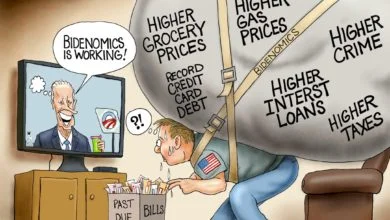Here’s Where Americans Are Feeling The Greatest Pain Under Biden’s Economy

Prices across the economy have skyrocketed since President Joe Biden first took office, hurting Americans in certain sectors more than others due to inflation and regulations, according to experts who spoke to the Daily Caller News Foundation.
Since January 2021, when Biden first took office, the consumer price index (CPI), a measure of inflation, has risen 17.1%, ending in October, according to the Federal Reserve Bank of St. Louis (FRED). Cost increases due to inflation and regulations are hitting every area of the economy, with housing, health care, appliances and car loans experiencing particularly significant impacts, according to experts who spoke with the DCNF.
“I would say that the effect on mortgage rates has been the thing most affected,” Michael Faulkender, chief economist and senior advisor for the Center for American Prosperity, told the DCNF. “Because of 40-year-high inflation from excessive government spending, the Federal Reserve has aggressively raised interest rates. When Joe Biden took office, the average 30-year mortgage rate was 2.77%. Today, it is 7.22%.”
Overall inflation reached a recent peak of 9.1% in June 2022 and has since decelerated to 3.2% in October year-over-year, still far above the Federal Reserve’s 2% target. In response to the high inflation, the Fed raised its federal funds rate to a range of 5.25% and 5.50%, the highest rate in 22 years, placing upward pressure on credit conditions.
The costs to pay for housing expressed in the CPI for shelter, which more closely follows the cost of rent, have risen 17.5% since Biden took office, slightly higher than general price increases, according to FRED.
Many economists point to high government spending under the Biden administration as one of the key causes of elevated inflation. Biden signed the American Rescue Plan in March 2021 and approved the Inflation Reduction Act in August 2022, which added $1.9 trillion and $750 billion in new spending, respectively.
“To put that number in perspective, at 2.77%, a $250k mortgage would have a monthly principal and interest payment of approximately $1,023 per month,” Faulkender told the DCNF. “At 7.22%, that same $250k loan has a payment of $1700 per month. That is why pending home sales have hit their lowest level in two decades. If one looks at rental costs, they have been one of the largest contributors to the ongoing inflation people are facing and it is usually the largest component of a household’s budget.”
In August 2023, a family with a median income could only afford a 30-year mortgage on a $356,272 home following interest rate and price increases, while that same family could afford a mortgage on a $737,392 house in December 2020.
“When some goods are hurt worse than others, the causes are not inflation,” Ryan Young, senior economist at the Competitive Enterprise Institute, told the DCNF. “Higher-than-inflation housing and health care costs are due to regulations and supply chain problems — or at least the higher-than-inflation parts are.”
Health care costs are being ratcheted up due to rising premiums, which increased 7% just this year as of October, increasing 22% over the last five years. In an effort to bring down prices, the Biden administration announced in August that it would be forcing negotiations on ten major drugs.
The Biden administration has outpaced the previous three administrations in terms of issuing significant regulations, calculated by those that have at least a $100 million economic impact, completing 89 by the end of 2022. The total added costs due to regulations on the economy are estimated to be $1.939 trillion.
Biden has made combating climate change a key part of his policy objectives, instituting and proposing a slew of environmental regulations that, if all approved, would ultimately add $9,166 in new costs for average Americans per home. Many of the regulations are targeted at ordinary household items like appliances, particularly gas furnaces, water heaters, air conditioners and more, in an attempt to reduce carbon emissions.
“The Fed is now keeping the money supply stable, which is why inflation is now under 4% instead of above 9%,” Young told the DCNF. “Raising interest rates has been part of that. The trouble is that has also raised rates on mortgages, car loans, small business loans and eaten away at people’s retirement savings and college funds. The trouble with inflation is that it hits everything.”
The average monthly payment for a car loan has increased from $617 in the third quarter of 2021 to $726 per month two years later, according to Experian. The combination of price increases and rising rates has led to an estimated half of Americans being priced out of the car market completely.
As a result of rising prices, Americans are spending through their savings, only holding a collective $768.6 billion in October. Comparatively, Americans held over $1 trillion in savings in May and nearly $6 trillion in April 2020.
“Long story short, inflation hits everything equally,” Young told the DCNF. “It’s a universal regressive tax. It hurts low-income families more because they have less room in their budgets to spare. Low-income families are also less likely to have interest-earning investments to help offset inflation.”
The White House did not respond to a request to comment from the DCNF.
Content created by The Daily Caller News Foundation is available without charge to any eligible news publisher that can provide a large audience. For licensing opportunities of our original content, please contact licensing@dailycallernewsfoundation.org




